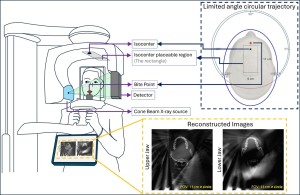Congress:
ECR25
Poster Number:
C-23680
Type:
Poster: EPOS Radiologist (scientific)
Authorblock:
S. M. R. S. Islam1, A. Biguri2, C. Landi3, G. Di Domenico4, P. Grün5, D. Turhani5, G. Kronreif1, W. Birkfellner6, S. Hatamikia7; 1Wiener Neustadt/AT, 2Cambridge/UK, 3Via Bolgara 2, Brusaporto (BG)/IT, 4Ferrara/IT, 5Steiner Landstraße 124, Krems/AT, 6Vienna/AT, 7Krems/AT
Disclosures:
S M Ragib Shahriar Islam:
Nothing to disclose
Ander Biguri:
Nothing to disclose
Claudio Landi:
Nothing to disclose
Giovanni Di Domenico:
Nothing to disclose
Pascal Grün:
Nothing to disclose
Dritan Turhani:
Nothing to disclose
Gernot Kronreif:
Nothing to disclose
Wolfgang Birkfellner:
Nothing to disclose
Sepideh Hatamikia:
Nothing to disclose
Keywords:
Interventional non-vascular, Cone beam CT, Digital radiography, CAD, Cost-effectiveness, Experimental investigations, Image verification, Kv imaging
Cone Beam Computed Tomography (CBCT) is an increasingly popular imaging technique for dental clinics, widely used for pre-operative planning and observation. Its popularity stems from:
- Low-cost imaging
- Compact, flexible design, easy mobility and maintenance
Despite these advantages, CBCT systems have a significant limitation:
- The small field of view (FOV) due to the restricted circular source-detector movement
This limitation results in insufficient planning data for treatment experts.

Fig 1: A typical small CBCT unit and the small FOV of reconstructed images
Current solutions and their challenges:
- Using a larger detector: Advantage: Expands the FOV Challenge: Increases imaging costs, as larger detectors are expensive
- Shifted detector scan: Advantage: Allows for a wider scan range Challenge: Introduces technical difficulties, requiring device modifications during scanning
Our proposed solution:
- A novel fusion source-detector trajectory that goes beyond the standard circular trajectory and can significantly increase the FOV
- The proposed novel trajectory integrates principles from two distinct scanning techniques
This work is based on our recently published research [1].